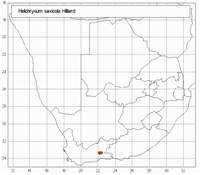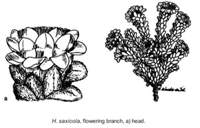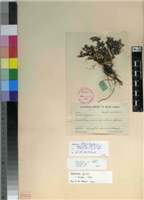Origin of name:
saxicola = growing among rocks
Diagnostic characters:
MatformingSolitary heads
Description:
Cushion-forming dwarf shrublet 30�50 mm high, old main stem up to c. 5 mm diam., gnarled, main branches prostrate, rooting, giving rise to innumerable tightly congested erect or ascending branchlets, closely leafy throughout. Leaves closely imbricate, 1�3 x 0.75�1.5 mm, elliptic, obtuse, base broad, clasping, both surfaces thickly greyish-white woolly-felted. Heads homogamous, campanulate, c. 5 x 4 mm, 7 mm across the radiating bracts, solitary, sessile at the branchlet tips. Involucral bracts in 5 series, graded, loosely imbricate, outer obtuse, whitish, webbed together with wool, tips of inner exceeding flowers, elliptic-oblong, obtuse, opaque snow-white. Receptacle with flattened tubercles. Flowers c. 22�24, yellow, the outermost tipped red. Achenes 1.25 mm long, with myxogenic duplex hairs. Pappus bristles many, equaling corolla, tips barbellate, shaft scabrid, bases not cohering.
In full flower in January.
Distribution:
Grows in rock crevices, 1 500 to 2 000 m. Recorded only from the top of Swartberg in Prince Albert and Oudtshoorn divisions.
Fynbos Biome.
Notes:
Closely allied to H. sessile and H. archeri but distinguished from both by its shorter and relatively broader leaves and by its blunter involucral bracts.Taxonomy:
Literature:
Helichrysum saxicola Hilliard in Flora of southern Africa 33,7 (2): 190 (1983).
Type:
Cape, Prince Albert div., Swartberg, between Kliphuisvlei and Plaatsberg, 6500 ft, Jan. 1954, Taylor 1095 (SAM, holo.)
Synonym(s):
Vouchers:
Pocock 62 (BOL; PRE); Esterhuysen 4533 (BOL); Stokoe 9081 (BOL); Stokoe 6772 (BOL); Esterhuysen 29567 (BOL); Stokoe SAM 62955 (SAM)


